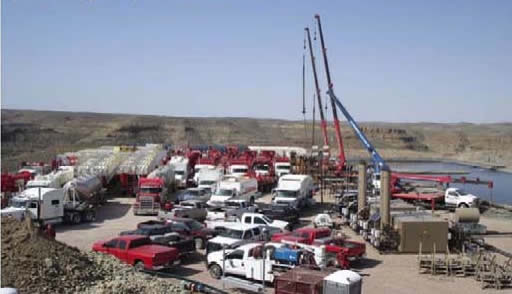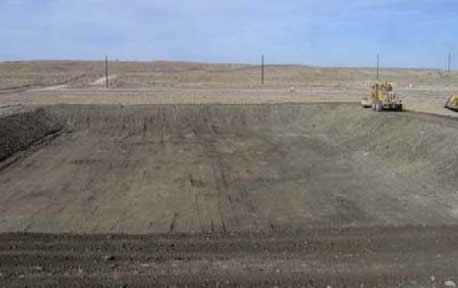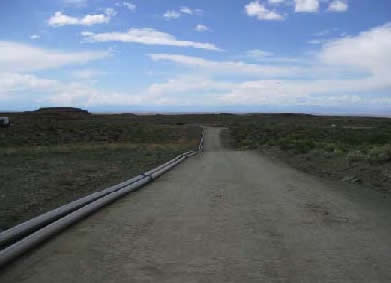| University of Colorado at Boulder | ||||||||
 |
||||||||
Spotlight: Anadarko’s Completion Transport System — ACTS Example of a crowded multi-well pad during completion operations. Example of a crowded multi-well pad during completion operations.Anadarko’s Completion Transport System (ACTS) is an award-winning example of centralizing storage and staging activities. Anadarko creates temporary staging sites on existing well pad locations to treat completion/flowback fluids. The company then moves filtered completion fluids by temporary pipelines directly to other well pads for completion activities. Prior to using ACTS, a typical four-well pad would require:
This completion scenario posed logistical challenges due to overcrowding. Instead of responding with larger disturbance areas at the multi-well pads to accommodate completion fluid tanks and associated equipment, Anadarko instituted ACTS. ACTS uses refurbished pits as staging areas for completion fluids.
|
||||||||
| Pit Refurbishment | |
|
Drilling fluid is evaporated or hauled to disposal after conclusion of drilling operations Fill dirt is mixed with remaining drilling mud solids and cuttings from the large end of the pit and moved to the small end of the pit Pit is re-lined with impermeable barrier to prevent infiltration |
 Pit ready for protective liner installation. Pit ready for protective liner installation. |
ACTS uses temporary surface lines to move completion fluids from one staging site to another.
| Temporary Surface Lines | |
|
Lines are hand-placed along existing roads and/or right-of-way Lines are visually inspected and pressure tested Lines are flushed with fresh water and then purged with compressed air into a truck or to the reserve pit before they are moved. |
 Temporary surface lines Temporary surface lines |
The benefits of ACTS include:
For more information on ACTS, see the presentation (ACTS: Anadarko Completion Transport System) given by Jeff Dufresne at the workshop, Opportunities and Obstacles to Reducing the Environmental Footprint of Natural Gas Development in the Uintah Basin in October 2010.
- Limits new distubrances by utilizing existing locations and/or right-of-way
- Reduces truck traffic
- Reduces road dust
- Preserves county and lease roads, improves driving conditions and safety
- Reduces truck emissions
- Decreases fresh water usage
- Accelerates reclamation by expediting pit closures
- Achieves operational improvements and time savings;
- Move fluid once
- Reduce the number of completion tanks needed
- Achieves overall cost reduction in operations
How Well Does it Work?
- Reduces the number of tanks on a 4-well drilling pad from ~100 to ~20
- Decreased the need for fresh water by approximately 2 million bbls by recycling ~80% of completion fluids (2010)
- Truck traffic was reduced by approximately 1.3 million miles in 2009 and 1.5 million miles in 2010
- Water cost savings estimated at $50,000 per 4-well pad (~$1.00 per bbl)
Recognizing Anadarko's BMPs
Anadarko received the Interstate Oil and Gas Compact Commission Chairman's Stewardship Award in 2010 for ACTS. For information on this and other Anadarko awards, go to the BMP Search page and include +award +anadarko in the Keywords panel.